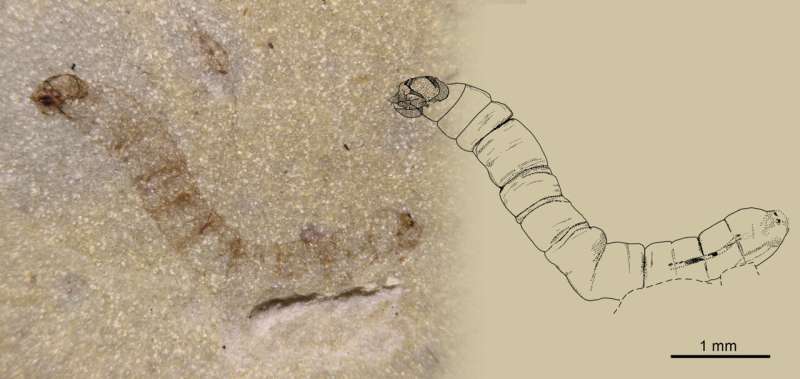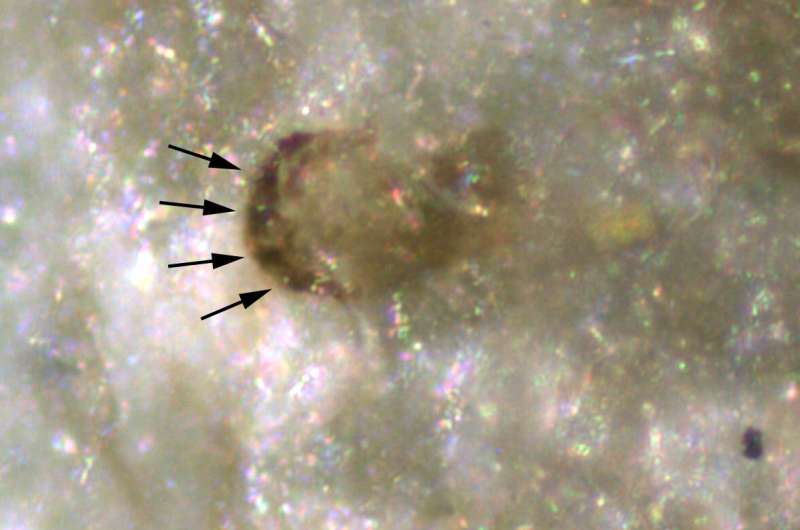This article has been reviewed according to Science X's editorial process and policies. Editors have highlighted the following attributes while ensuring the content's credibility:
fact-checked
trusted source
proofread
Discovery of oldest known fossil gnat shows how insects adapted to a postapocalyptic world

Near the small harbor of Estellencs at the northeast of Mallorca (Balearic Islands, Spain), a pebbly beach can be found at the base of an impressive scarp that threatens rockfall. Remains of plants, crustaceans, insects, and fish have been discovered in the gray-blue rock layers formed from sediments deposited 247 million years ago. Fossils in these rocks are of great interest since they offer a window into the time where the planet was recovering from the greatest mass extinction.
A few years ago, Mallorcan researcher Josep Juárez made a surprising find during a paleontological survey in the area—a complete insect larva that had left a slight imprint of organic remains on the two sides that were left exposed when the rock split in half. The detailed study of the fossil had to wait, but eventual examination with a powerful microscope revealed that it was a unique discovery.
The larva, very well preserved, belongs to a group of insects that we all know, the dipterans—that is, true flies, mosquitoes, midges, and gnats. Although thousands of fossil dipterans have been found across the globe, both in thinly layered rocks and in amber, this specimen, 247 million years old (early Middle Triassic)—older than the earliest dinosaurs—is the oldest dipteran ever found. This record was previously held by fossils found in France, about one or two million years younger than those from Estellencs.
Enrique Peñalver, from the Spanish National Research Council (CSIC) at the Spanish Geological Survey (CN-IGME), and first author of the recent study on the new fossil published in Papers in Palaeontology, says, "While I was inspecting it under the microscope, I put a drop of alcohol on it to increase the contrast of the structures, and I was able to witness in awe how the fossil had preserved both the external and internal structures of the head, some parts of the digestive system, and, most importantly, the external openings to its respiratory system, or spiracles."

Rafel Matamales-Andreu, paleontologist from the Balearic Museum of Natural Sciences (FJBS-MBCN) and another author of the study, has devoted several years to unravel the environment of this region during the Triassic period, and the changes it underwent for millions of years. "If we were able to visit the region at the beginning of the Triassic, we would see large rivers and floodplains under a climate similar to that found in tropical Africa today, alternating dry and rainy seasons," he points out.
This larva fed on organic matter from the soil "just" a few million years in the aftermath of likely the most dramatic mass extinction in the history of life on Earth, which erased more than 80% of the species and led to the end of the Palaeozoic Era. "We have been able to look at some of the adaptations by the first dipterans to the postapocalyptic environment at the beginning of the Triassic, for instance, a breathing system that is still found in different groups of insects today," remarks Ricardo Pérez-de la Fuente, from Oxford University Museum of Natural History and also an author of the study.

The authors have described a new genus and species related to modern window- or wood-gnats named Protoanisolarva juarezi, or "Juárez's ancestral anisopodoid larva," honoring its discoverer. This precious fossil is currently being conditioned at the Catalan Institute of Paleontology Miquel Crusafont for its permanent custody in Mallorca.
More information: Enrique Peñalver et al, Early adaptations of true flies (Diptera) to moist and aquatic continental environments, Papers in Palaeontology (2022). DOI: 10.1002/spp2.1472
Provided by University of Oxford





















